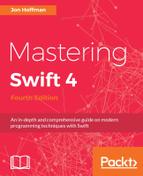In this section, we will demonstrate how to use the command pattern by creating a Light type. In this type, we will define the lightOnCommand and lightOffCommand commands and will use the turnOnLight() and turnOffLight() methods to invoke these commands. We will begin by creating a protocol named Command, which all of the command types will conform to. Here is the command protocol:
protocol Command {
func execute()
}
This protocol contains a method named execute(), which will be used to execute the command. Now, let's look at the command types that the Light type will use to turn the light on and off. They are as follows:
struct RockerSwitchLightOnCommand: Command {
func execute() {
print("Rocker Switch:Turning Light On")
}
}
struct RockerSwitchLightOffCommand: Command {
func execute() {
print("Rocker Switch:Turning Light Off")
}
}
struct PullSwitchLightOnCommand: Command {
func execute() {
print("Pull Switch:Turning Light On")
}
}
struct PullSwitchLightOffCommand: Command {
func execute() {
print("Pull Switch:Turning Light Off")
}
}
The RockerSwitchLightOffCommand, RockerSwitchLightOnCommand, PullSwitchLightOnCommand, and PullSwitchLightOffCommand commands all conform to the Command protocol by implementing the execute() method; therefore, we will be able to use them in the Light type. Now, let's look at how to implement the Light type:
class Light {
var lightOnCommand: Command
var lightOffCommand: Command
init(lightOnCommand: Command, lightOffCommand: Command) {
self.lightOnCommand = lightOnCommand
self.lightOffCommand = lightOffCommand
}
func turnOnLight() {
self.lightOnCommand.execute()
}
func turnOffLight() {
self.lightOffCommand.execute()
}
}
In the Light type, we start off by creating two variables, named lightOnCommand and lightOffCommand, which will contain instances of types that conform to the Command protocol. We then create an initiator that lets us set both of the commands when we initiate the type. Finally, we create the turnOnLight() and turnOffLight() methods that we will use to turn the light on and off. In these methods, we call the appropriate command to turn the light on or off.
We would then use the Light type as follows:
var on = PullSwitchLightOnCommand() var off = PullSwitchLightOffCommand() var light = Light(lightOnCommand: on, lightOffCommand: off) light.turnOnLight() light.turnOffLight() light.lightOnCommand = RockerSwitchLightOnCommand() light.turnOnLight()
In this example, we begin by creating an instance of the PullSwitchLightOnCommand type named on and an instance of the PullSwitchLightOffCommand type named off. We then create an instance of the Light type using the two commands that we just created and call the turnOnLight() and turnOffLight() methods of the Light instance to turn the light on and off. In the last two lines, we change the lightOnCommand method, which was originally set to an instance of the PullSwitchLightOnCommand class, to an instance of the RockerSwitchLightOnCommand type. The Light instance will now use the RockerSwitchLightOnCommand type whenever we turn the light on. This allows us to change the functionality of the Light type during runtime.
There are several benefits from using the command pattern. One of the main benefits is that we are able to set which command to invoke at runtime, which also lets us swap the commands out with different implementations that conform to the Command protocol as needed throughout the life of the application. Another advantage of the command pattern is that we encapsulate the details of command implementations within the command types themselves rather than in the container type.
Now, let's look at the last design pattern, which is the strategy pattern.
